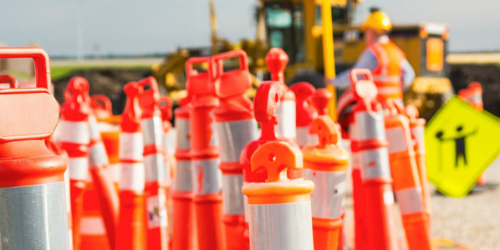Traffic Control

Traffic control can be temporary or permanent. Everyone is familiar with traffic lights, lane markings, stop signs, pedestrian crossings, etc. as standard traffic control devices. These are permanent management and control devices for normal traffic flow. When road work must be performed, or high congestion expected, additional measures are utilized. In these situations, worker safety and protection is critical.
During road construction projects, workers are exposed to traffic. Programs are in place for separating traffic from road construction or maintenance work. These include placing concrete or water-filled plastic barricades (K-rails or Jersey barriers) along streets and highways for long term projects, or providing escorts for short duration, mobile operations such as street sweeping. Other traffic control methods include reducing lanes or restricting vehicle movement to single lane with the use of cones. These short duration projects will often involve the use of traffic management persons, known as “flaggers”. These workers regulate dynamic traffic movement by the use of signs. They are in the line of traffic and have specific regulations. Flaggers must be trained and wear high visibility Personal Protective Equipment. Flaggers are also employed at school crossings and at events where traffic movement and congestion is high and interacts with pedestrian traffic.
To get more information on the applicability of traffic control for a specific County operation please contact the corresponding departmental Safety Coordinator.
For further information on specific regulatory guidelines please refer to the link(s) below:
Vehicle, Traffic Control, Flagger Regulations (Cal-OSHA Construction Safety Orders)
Manual on Uniform Traffic Control Devices (MUTCD) (CalTrans)
 Translate
Translate